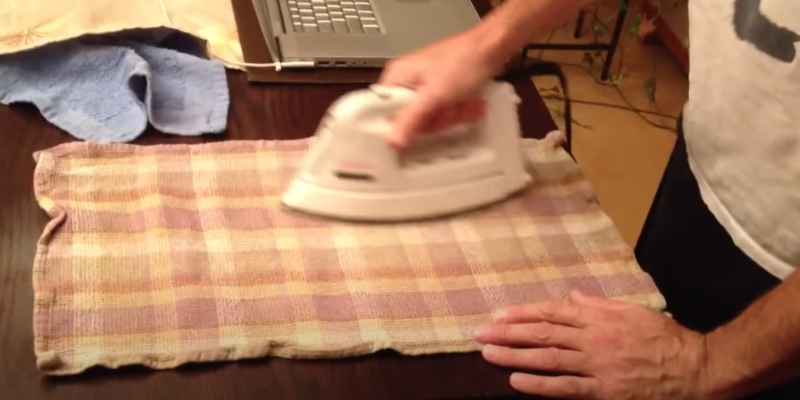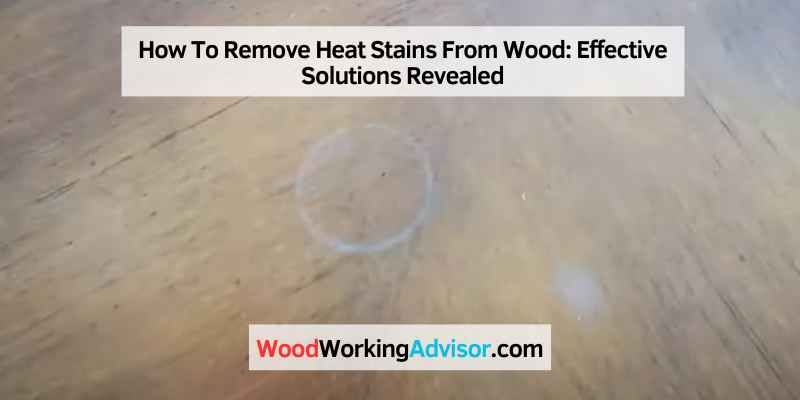To remove heat stains from wood, mix equal parts baking soda and regular white toothpaste, then gently rub the mixture onto the stain in circular motions using a soft cloth. In addition, consider using mayonnaise or non-gel toothpaste as alternative options for removing heat stains from wood surfaces.
Wood furniture is beautiful and timeless, but it is susceptible to heat stains that can mar its appearance. These unsightly marks are often left behind by hot dishes or items placed directly on the wood surface. If you find yourself dealing with heat stains on your wood furniture, there’s no need to panic.
With some simple household ingredients and a little elbow grease, you can easily remove these stains and restore the natural beauty of your wood furniture. We will explore effective methods for removing heat stains from wood surfaces, providing you with all the information you need to tackle this common problem.
Natural Remedies
If you’ve accidentally left a hot object on your wooden furniture, you may have discovered an unsightly heat stain left behind. Fortunately, there are natural remedies that can help restore your wood’s beauty without damaging the surface. In this article, we’ll explore two effective methods using common household items: Lemon Juice and Olive Oil, and Baking Soda and Toothpaste.
Lemon Juice And Olive Oil
One of the simplest and most effective natural remedies for heat stains on wood involves the use of lemon juice and olive oil. Here’s how you can easily restore your wooden surface:
- Combine equal parts lemon juice and olive oil in a small bowl.
- Dip a clean cloth into the mixture, ensuring it is saturated but not dripping.
- Gently rub the cloth onto the heat stain, following the direction of the wood grain.
- Continue rubbing until the stain begins to fade, applying more of the lemon juice and olive oil mixture as needed.
- Once the stain has disappeared, wipe away any excess mixture with a separate clean cloth.
Baking Soda And Toothpaste
If you don’t have lemon juice and olive oil on hand, you can try using baking soda and toothpaste to remove heat stains from wood. Follow these simple steps:
- In a small bowl, mix together a tablespoon of baking soda and a teaspoon of toothpaste.
- Using a clean cloth or sponge, apply the mixture onto the heat stain.
- Gently rub the mixture into the wood, following the direction of the grain.
- Continue rubbing until the heat stain begins to fade.
- Once the stain is gone, wipe away any residue with a clean cloth.
These natural remedies can effectively remove heat stains from wood, helping you restore the natural beauty of your furniture. Remember to always test any treatment on a small, inconspicuous area first and to follow the grain of the wood when applying the remedies. With a little patience and the right ingredients, you can say goodbye to those pesky heat stains and enjoy your wooden surfaces once again.

Chemical Solutions
Remove heat stains from wood effortlessly with chemical solutions. These solutions are effective in restoring the natural beauty of your wooden surfaces.
Wooden furniture can easily fall victim to heat stains, leaving unsightly marks that can ruin the overall appearance. When faced with these stubborn blemishes, chemical solutions can come to your rescue. In this section, we will explore some effective heat stain remover products, including the highly regarded Oxalic Acid.
Heat Stain Remover Products
1. Oxalic Acid:
Oxalic Acid is a powerful chemical solution that works wonders in removing heat stains from wood. This crystalline substance can be found in many hardware stores and is relatively easy to use.
2. Other Commercial Heat Stain Removers:
In addition to Oxalic Acid, there are various commercial products available specifically designed to remove heat stains from wood surfaces. These products often come in spray or liquid forms and can be easily applied to the affected area.
Oxalic Acid
What is Oxalic Acid?
Oxalic Acid is a naturally occurring compound found in many plants, such as rhubarb and spinach. It can also be synthesized for commercial use. When used as a heat stain remover, Oxalic Acid acts as a bleaching agent that lightens the affected area, effectively removing the stain.
How to Use Oxalic Acid:
Using Oxalic Acid to remove heat stains requires careful handling due to its corrosive properties. Here is a step-by-step guide on how to use Oxalic Acid safely:
- Prepare a mixture: Dissolve Oxalic Acid crystals in warm water, following the manufacturer’s instructions for the appropriate ratio. This will create an Oxalic Acid solution.
- Apply the solution: Wearing protective gloves and eyewear, dampen a clean cloth with the Oxalic Acid solution. Gently rub the cloth over the heat stain, ensuring full coverage.
- Allow it to sit: Leave the solution on the stain for a few minutes to allow the Oxalic Acid to penetrate and break down the heat stain.
- Wipe away: After the designated time, use a clean, damp cloth to wipe away the Oxalic Acid solution and the heat stain. Ensure that the wood is thoroughly rinsed afterwards to remove any remaining residue.
- Apply a wood finish: Once the stain is completely removed and the wood is dry, apply a suitable wood finish, such as wax or varnish, to restore the wood’s natural beauty and protect it from future damage.
Precautions:
– It’s crucial to wear protective gear, such as gloves and eyewear, when handling Oxalic Acid to prevent any contact with the skin or eyes.
– Ensure proper ventilation in the area where you are working, as the fumes from Oxalic Acid can be harmful.
– Always follow the manufacturer’s instructions and guidelines when using Oxalic Acid or any other chemical solution.
By using chemical solutions like Oxalic Acid, you can effectively remove stubborn heat stains from your wooden furniture, restoring them to their former glory. Remember to exercise caution and closely follow the instructions to achieve optimal results. With these powerful stain removers at your disposal, you can bid farewell to those unsightly heat stains and enjoy the beauty of your wood furniture once again.
Preventive Measures
Looking to remove heat stains from wood? Discover effective preventive measures to keep your wooden surfaces stain-free and in pristine condition.
Using Coasters And Trivets
Using coasters and trivets is a simple yet effective way to prevent heat stains on your wood furniture. Coasters provide a protective barrier between hot items such as mugs, glasses, and plates and the wood surface. Trivets, on the other hand, are larger and can accommodate multiple hot items at once, making them ideal for serving trays or hot dishes. By utilizing coasters and trivets, you can prevent heat from directly transferring to the wood, reducing the chances of unsightly stains.
Using Heat-resistant Mats
Heat-resistant mats are another great preventive measure to combat heat stains on your wood furniture. These mats are specifically designed to withstand high temperatures and offer a protective layer between the hot item and the wood surface. Place the heat-resistant mat under hot dishes, pots, or pans when cooking or serving meals. This will ensure that heat is distributed evenly and minimize any potential damage to the wood.
But how do heat-resistant mats actually work? These mats are typically made from materials that have excellent thermal conductivity, meaning they can effectively dissipate heat. They act as a buffer, absorbing and distributing the heat evenly across the mat’s surface, thus preventing concentrated heat from directly reaching the wood. This way, you can enjoy your hot meals without worrying about heat stains on your beloved wood furniture.
Now let’s explore some more preventive measures to keep your wood furniture looking pristine.
Using Protective Pads
Protective pads or felt pads are another excellent option for safeguarding your wood furniture against heat stains. These pads are typically made from soft materials, such as felt or rubber, and can be easily applied to the bottom of appliances, electronics, or decorative objects. When these items are placed on your wood surface, the pads create a cushioning effect, reducing the direct contact between the heat source and the wood. This helps prevent any potential heat damage and keeps your furniture looking as good as new.

Keeping Surfaces Clean And Dry
Maintaining cleanliness and dryness on your wood surfaces is crucial for preventing heat stains. Any moisture or spills left on the wood surface can react with heat, creating unsightly marks or discoloration. Therefore, it is important to regularly clean and wipe down your wood furniture to remove any excess moisture or spills. Ensure you use a soft cloth or sponge and gentle cleaning products suitable for wood surfaces. By keeping your furniture clean and dry, you reduce the risk of heat stains and maintain its natural beauty.
In conclusion, taking preventive measures is key to ensuring your wood furniture remains free from heat stains. By using coasters and trivets, heat-resistant mats, protective pads, and keeping surfaces clean and dry, you can protect your furniture from the damaging effects of heat. Implementing these simple steps will not only enhance the lifespan of your wood furniture, but also keep it looking beautiful for years to come.
Conclusion
In a nutshell, by following these effective methods, you can easily bid farewell to those pesky heat stains on wood surfaces. Remember to be cautious and try the least invasive methods first, progressing towards more aggressive options if needed. With a little patience and the right tools, your wood furniture can be restored to its former glory.
So don’t let heat stains get you down – take action and enjoy the beauty of your wood without any unsightly blemishes. Happy cleaning!


